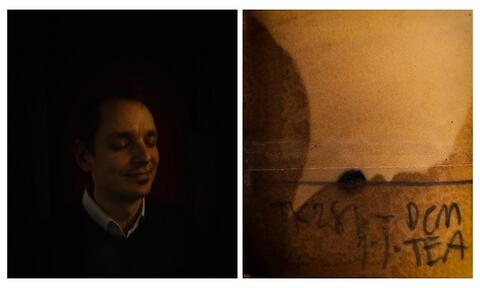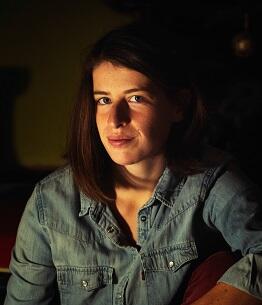
“Research without filter”: a chiaroscuro photograph
As part of the exhibition Research without filters, which will be held on the campus of the Faculty of Science and Engineering from October 10 to November 4, photographer Juliette Pavy was inspired by the complex world of research of Mickaël Ménand, professor-researcher at the Parisien of Molicular Chemistry (Sorbonne Université/CNRS) to offer a new artistic perspective on the scientific world.
Juliette, how were you inspired by Mickaël’s research work to create this photograph? Can you tell us about the creative process behind this image?
Juliette Pavy: It was a completely new experience. Mickaël was the first scientist I met as part of this project. I was still looking for ways to approach the different scientific disciplines and maintain a certain coherence in my work. When I visited his laboratory, details immediately caught my attention, in particular the lab notebooks and the chromatographies1. I had in mind the idea of capturing a detail of Mickaël’s research while keeping the human at the center of the image. In the end, I opted for a diptych, which mixes a portrait of Mickaël and a detail of a chromatography.

Why this artistic choice to juxtapose a portrait of a researcher with an element of research?
J.P.: I found that this allowed the creation of a visual dialogue between the researcher and his subject. It reminds us that there are humans behind these complex experiments. For me, the portrait with Mickaël’s eyes closed symbolizes a form of intense concentration or even a scientific reverie. While the detail of the chromatography gives a window on the universe of his research. These two elements complement each other.
Mickaël, how did this collaboration with Juliette go to visually represent the concepts of your research in chemistry?
Mickaël Ménand: It was truly a challenge! My research focuses on anti-aromatic molecules, which change color depending on their state, from purple to green to red. This visual link seemed most obvious to me for our collaboration. But it is very difficult to translate the subtlety of our scientific research into a single image.
That said, Juliette's choice to focus on a detail of chromatography was relevant. We regularly do chromatography to purify our products, so it illustrates one of the aspects of our daily life in the laboratory.
Do you think this photograph could help the public better understand your research?
M.M.: Understand? I don’t think so. Our research is more complex, and a photo can’t convey all the subtleties of the subject. But it can give a concrete impression of what we’re doing, the material we’re handling. The text accompanying the photo is crucial to provide a clearer context to the viewer.
Juliette, what were the main technical or artistic challenges you encountered in creating this portrait?
J.P.: The first challenge was the lab environment: cold spaces, unflattering lights. So I chose to add a small neon light to harmonize the portraits with the colors of the research details I was photographing. It was also an opportunity to take the time to think about the image I wanted to create, which is quite rare in my work, which is more oriented towards press photography where everything is done more quickly.
Mickaël, are there aspects of Juliette’s work that surprised you or gave you a new perspective on your research?
M.M.: Yes, the choice of chromatography surprised me. I didn’t expect it to take on this particular aspect of our work. It’s a process that we use often, but seeing it highlighted in such an artistic and visual way was new. It helps to concretize what we do, even if it can’t fully convey the complexity of our research.
What did you enjoy most about this collaboration?
M.M.: This allowed me to step outside my usual framework and project myself into the eyes of an outside observer who is discovering our work. This is an exercise that we don’t often do as scientists, so it was interesting to see ourselves from a new angle.
J.P.: For me, it was also a way to get out of my comfort zone. Entering a lab without knowing anything about the subjects, and then having to summarize all that in an image, was a challenge. But it was also exciting, especially when Mickaël explained his research to me, such as his research on Möbius strip molecules, a concept that fascinated me.
1 : a technique for separating the different substances present in a mixture

The photo deciphered by Juliette Pavy
In this diptych, we see Mickaël, his eyes closed, bathed in a dark and contrasting light, with golden-yellow tones that recall those of the detail of the adjacent photograph. These two images dialogue with each other.
The chosen detail, is a thin-layer chromatography that comes from a laboratory notebook of Mickaël's team, in which the researchers record their experiments and their results.
We can distinguish a sort of golden wave, with in its center a small spot, almost a point, which evoked the image of a planet for me. We do not really know if we are observing a landscape, something underground, or even in another dimension. There is a real ambiguity that transports us to another place.
